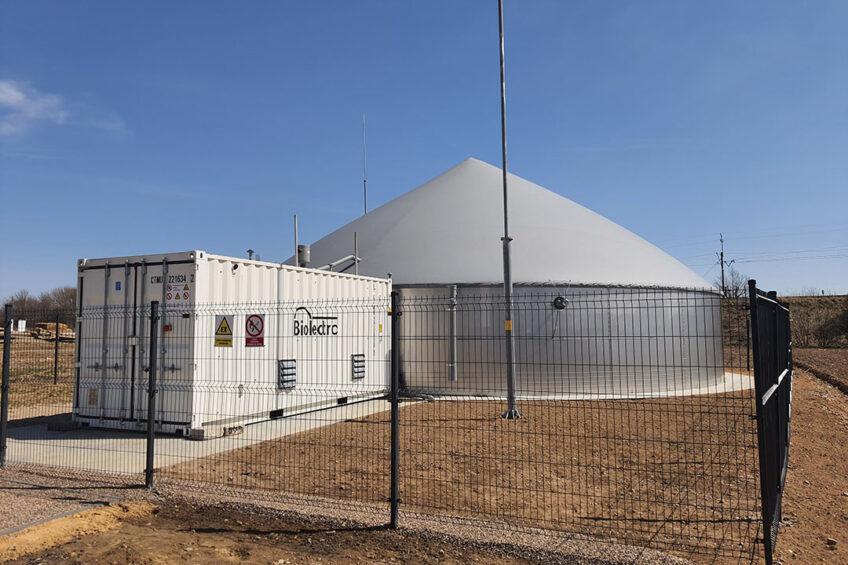Reaping the benefits of mini-biodigesters

Biodigesters have become very popular in recent years – Germany, for instance, is full of them as many farms have 1 or more. Regular biogas plants are relatively sizeable so they represent high investments and require space. Small biodigesters could therefore be a solution.
Biodigesters are the most effective way to slash methane emissions from pig farms, with methane being well known as a very intense greenhouse gas. In the digesters, methane from bacteria “digesting” the manure is captured, then cleaned and burned to generate heat for farm buildings and electricity for the farm. (Yes, carbon dioxide is emitted to the atmosphere during this process, but carbon dioxide is a much less intense greenhouse gas than methane.)
Some jurisdictions also enable farmers to sell excess electricity to the local electricity provider, creating another farm revenue stream. In addition, the use of a digester to process manure, compared to a manure lagoon or the application of raw manure to fields, greatly reduces manure odour.
Mini digesters
But because traditional-sized biodigesters are pricey and also not feasible for farms with fewer pigs or cows, at least 2 digester technology firms – Biolectric and HoSt – offer “minis”. These smaller versions are a fraction of the cost of their full-sized cousins and provide other advantages.
For example, they generally require only a simple permit from the local government as compared to the long approval process generally needed with a large digester. They also come pre-constructed and are very quick to install. In addition, minis are designed to run on manure alone, where their large cousins often have a requirement for off-farm feedstock (especially fats) to ensure the bacteria thrive properly.
There are 2 parts, the digester and the attached self-contained and automated control system. The system automatically pumps a fixed amount of manure from the “reactor” to digestate storage every day and supplements the discharged volume with fresh manure from the manure pit.

Extent of use biodigesters
Biolectric of Belgium seems to be the only digester firm so far to have minis located on pig farms. The company has installed over 300 minis, almost all of them in Europe and the rest in North America. Almost all are located on dairy farms.
“There are approximately 8 to ten installations on pig farms,” says Biolectric’s Jules Dobbels. “Some of those work only with pig manure, and some use a mixture of dairy slurry and pig manure. In addition, we have about five installations to come which will have only pig manure.”
The online MyBiolectric app informs a producer in real time how much electricity is being produced and how adjustments can be made to increase digester efficiency. In general, the farmer only needs to check in with the mini for about ten minutes a day.
Operational details
Biolectric’s Poland distributor Naturalna Energia has installed 45 minis in that country, with 10 on pig farms and 5 of those in the process of start-up. Naturalna’s technical marketing leader Adam Orzech notes that more mini installations would have been finished on Polish pig farms in 2021, but this was blocked by the African Swine Fever (ASF) outbreaks of the last few years. The next 6 are in production in Belgium.
While pig slurry is more difficult to manage in terms of the digester process compared to dairy cow slurry, Biolectric has found solutions. “The reason [for difficulties] is not only significantly reduced dry matter level, but also other features and characteristics such as high stratification and a high variety of types of pig slurry,” Orzech says.
The solution to the problem of high slurry stratification is to use an additional mixer both in the manure pit and in the mini’s silo. Orzech adds that at the start, the addition of micro-elements to improve bacteria proliferation is often required.
The low dry matter level of pig manure is addressed through a bigger silo on the Biolectric mini, which pumps more slurry per day. Orzech notes that the 44kW size mini needs a minimum of 30m3/day porker slurry or a minimum of 40m3/day of slurry from sows and gilts. Orzech says, “Based on this feeding, the first mini-installation on a Polish pig farm produced 355,000 kWhe/year and the second 312,000 kWhe/year. With Poland’s conditions and regulations, both installations provide a return on investment of up to eight years without any subsidies.”
Number of pigs required
Orzech and his colleagues have worked with university extension personnel and have determined the number of pigs required to supply a 44kW mini:
Finisher pig farms: 4,000 to 5,600;
Sow farms: 700 to 900; and
Closed cycle farms: 400 to 500 sows.
Orzech explains that, before farmer investment, “We organise a slurry test in terms of biogas production and biogas methane content. This laboratory study determines how big an installation we can deliver with success.”
He adds, “It’s not only energy production and the payback period that are important to our customers. Farmers who converted the slurry into digestate have a much more open way in the fertilisation of arable land and use much less fertiliser lime to reduce soil acidification. Of course, many customers also use heat to heat buildings.”
Dobbels says, “Despite the fact that pig farms are still a small part of the installed base, we strongly believe in the potential, and in the coming months and years we are going to put more effort into it.”
 Beheer
Beheer






 WP Admin
WP Admin  Bewerk bericht
Bewerk bericht